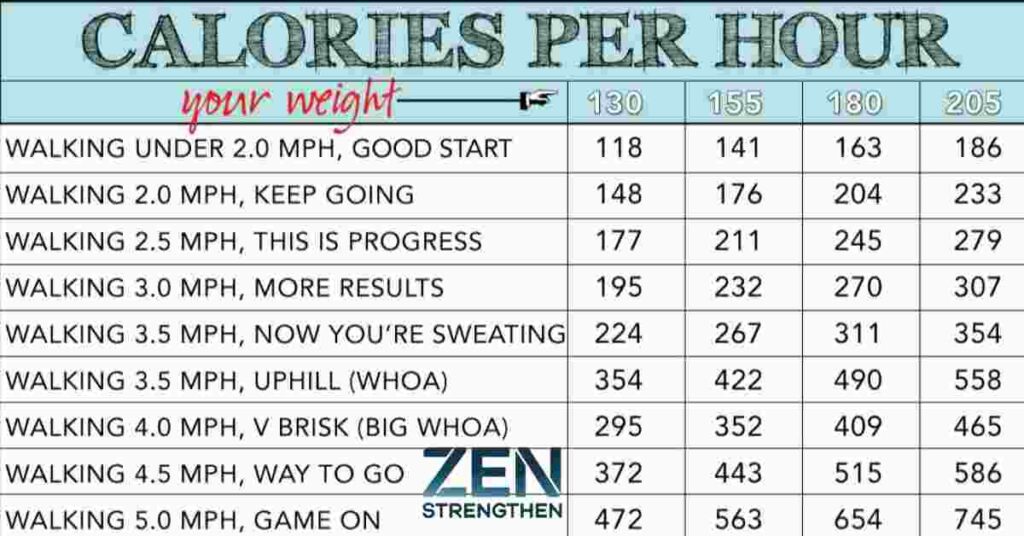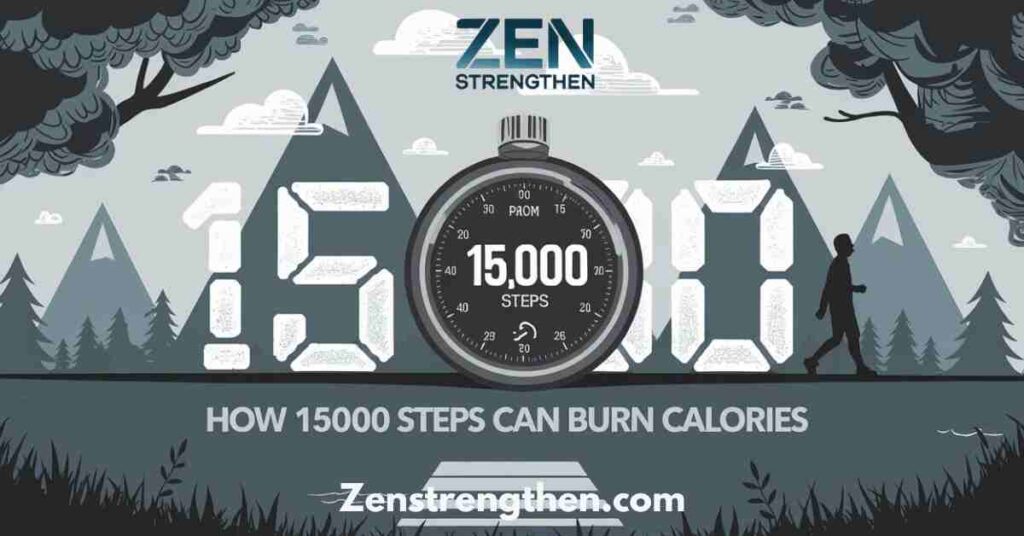In today’s health-conscious world, the pursuit of effective exercise routines is an ongoing journey. Among the myriad of fitness trends, one that’s gained substantial traction is the 15000 steps for improving your calories burn challenge.
But what’s the real impact of this walking phenomenon on your caloric burn and overall well-being? Let’s embark on a comprehensive exploration of this popular fitness goal, uncovering the facts, benefits, and strategies to optimize your step count for maximum health gains.
The 15,000 Step Challenge: A Journey Beyond Numbers

Have you ever pondered the true value of those 15,000 steps? As fitness trackers become an integral part of our daily lives, more and more individuals are pushing past the conventional 10,000-step milestone. But what’s the actual significance of this increased physical activity?
Walking 15,000 steps isn’t merely about reaching a number on your pedometer. It’s a dedication to your health, a daily ritual with the potential to revolutionize your body and mind. Let’s dissect what this challenge truly entails for your caloric burn and holistic well-being.
Decoding Calorie Burn: The Intricate Science Behind Your Steps
Before we delve into the specifics of 15,000 steps, it’s crucial to grasp the mechanics of how our bodies burn calories. Energy expenditure isn’t a simple equation of movement; it’s a complex interplay of various physiological factors.
Demystifying Calories and Energy Expenditure
At its core, a “calorie” is a unit of energy. When we discuss burning calories, we’re referring to the energy your body consumes to function. This encompasses everything from basic biological processes like breathing to high-intensity activities like marathon running.
The Multifaceted Factors Influencing Calorie Burn
Your caloric burn isn’t solely determined by the number of steps you take. Several key factors influence how many calories you burn:
- Age: Generally, younger individuals burn more calories due to higher metabolic rates.
- Weight: Heavier people typically burn more calories during physical activities due to the increased effort required to move their body mass.
- Gender: Men often burn more calories than women, primarily due to higher muscle mass, which is more metabolically active.
- Fitness level: The more fit you are, the more efficient your body becomes at burning calories, though this can also mean you may need to work harder to continue seeing results.
- Walking speed: A brisker pace leads to higher calorie burn as it requires more energy output.
- Terrain: Uphill walking burns significantly more calories than walking on flat surfaces due to the additional effort required to overcome gravity.
- Muscle mass: More muscle means a higher resting metabolic rate, leading to increased calorie burn even when not exercising.
- Genetics: Some people naturally have a faster metabolism, affecting their calorie burn rate.
Unraveling the Concept of Basal Metabolic Rate (BMR)
Your BMR represents the number of calories your body burns at rest to maintain basic life functions. It’s the foundation of your daily caloric burn. Understanding your BMR is essential for accurately estimating the additional calories burned through activities like walking.
To calculate your BMR, you can use the Harris-Benedict equation:
For men: BMR = 88.362 + (13.397 × weight in kg) + (4.799 × height in cm) – (5.677 × age in years) For women: BMR = 447.593 + (9.247 × weight in kg) + (3.098 × height in cm) – (4.330 × age in years)
Breaking Down the Numbers: Calories Burned in 15000 Steps

Now, let’s dive into the heart of the matter: how many calories do 15,000 steps actually burn?
Average Calorie Burn for 15000 Steps
On average, a person burns about 30-40 calories per 1,000 steps they walk. Therefore, 15,000 steps could potentially burn approximately 450-600 calories. However, this is a rough estimate and can vary widely based on individual factors.
Calculation Methods and Tools
To get a more accurate estimate, you can use online calorie calculators that take into account your weight, age, gender, and walking speed. Many fitness trackers also provide personalized calorie burn estimates based on your biometric data and activity level.
Real-life Examples for Different Body Types and Activity Levels
Let’s examine some examples to illustrate how calorie burn can vary across different individuals:
| Person | Weight | Age | Gender | Walking Speed | Estimated Calories Burned in 15,000 Steps | BMI | Fitness Level | Terrain | Time to Complete |
| Alex | 150 lbs | 30 | Female | 3 mph | 525 calories | 22 | Moderate | Flat | 2.5 hours |
| Sam | 200 lbs | 45 | Male | 3.5 mph | 750 calories | 27 | Active | Hilly | 2.15 hours |
| Jordan | 180 lbs | 60 | Male | 2.8 mph | 600 calories | 24 | Sedentary | Flat | 2.7 hours |
| Emma | 130 lbs | 25 | Female | 4 mph | 600 calories | 21 | Very Active | Mixed | 1.9 hours |
| Michael | 220 lbs | 50 | Male | 3 mph | 825 calories | 30 | Overweight | Flat | 2.5 hours |
| Sophia | 140 lbs | 35 | Female | 3.2 mph | 550 calories | 23 | Active | Urban (stairs) | 2.35 hours |
| David | 170 lbs | 40 | Male | 3.8 mph | 700 calories | 25 | Very Active | Trail | 2 hours |
| Linda | 160 lbs | 55 | Female | 2.5 mph | 500 calories | 26 | Moderate | Treadmill | 3 hours |
These examples demonstrate how personal factors can significantly impact calorie burn, highlighting the importance of individualized approaches to fitness goals.
The Science Behind Step-Based Calorie Burn

Understanding the mechanics of how your body burns calories during walking can help you optimize your workout and achieve your fitness goals more effectively.
How the Body Burns Calories During Walking
Walking engages multiple muscle groups, primarily in your legs and core. As these muscles work, they require energy, which comes from burning calories. The more muscles engaged and the harder they work, the more calories you burn.
During walking, your body primarily uses aerobic metabolism, which means it’s using oxygen to convert stored energy (glycogen and fat) into usable energy (ATP) for your muscles. This process not only burns calories during the activity but can also lead to an “afterburn” effect, where your body continues to burn calories at an elevated rate even after you’ve stopped walking.
The Role of Intensity: Casual Strolling vs. Power Walking

The intensity of your walk plays a crucial role in calorie burn. Power walking at a brisk pace can burn up to 50% more calories than casual strolling. This is because it elevates your heart rate and engages more muscle fibers, particularly in your core and upper body.
To illustrate:
- Casual strolling (2 mph): Burns about 170 calories per hour for a 150-pound person
- Brisk walking (3.5 mph): Burns about 270 calories per hour for the same person
- Power walking (4.5 mph): Can burn up to 340 calories per hour
Impact of Terrain and Incline on Calorie Expenditure
Walking on varied terrain or inclines can significantly boost your calorie burn. Uphill walking can increase calorie burn by up to 60% compared to walking on a flat surface. This is why hiking is such an effective calorie-burning activity.
For example:
- A 150-pound person walking on a flat surface for an hour might burn 270 calories
- The same person walking uphill for an hour could burn up to 432 calories
Beyond the Numbers: Health Benefits of 15,000 Steps
While calorie burn is important, the benefits of walking 15,000 steps daily extend far beyond weight management. Let’s explore the multifaceted health advantages of this daily walking goal.
Cardiovascular Improvements
Regular walking can strengthen your heart, lower blood pressure, and reduce the risk of heart disease. It’s an excellent form of cardiovascular exercise that’s accessible to most people. Studies have shown that walking can:
- Reduce the risk of coronary heart disease by 19%
- Lower the risk of stroke by 30%
- Improve cholesterol levels, particularly by increasing HDL (good) cholesterol
Weight Management Potential
Consistently walking 15,000 steps can create a calorie deficit, which is crucial for weight loss. Combined with a balanced diet, it can be an effective strategy for long-term weight management. Research indicates that:
- Walking 15,000 steps daily can lead to a weight loss of about 1 pound per week, assuming no change in diet
- Regular walkers have a lower body mass index (BMI) and waist circumference compared to sedentary individuals
Mental Health and Cognitive Benefits
Walking isn’t just good for your body; it’s great for your mind too. Regular physical activity has been shown to:
- Reduce stress, anxiety, and depression by up to 30%
- Improve cognitive function and reduce the risk of dementia by up to 40%
- Boost creativity and problem-solving skills
- Enhance mood and self-esteem
“Walking is man’s best medicine.” – Hippocrates
This ancient wisdom holds true today, as modern research continues to uncover the myriad health benefits of regular walking.
Maximizing Your 15,000 Steps: Strategies for Optimal Calorie Burn

Want to get the most out of your 15,000 steps? Try these strategies to boost your calorie burn and overall fitness:
- Incorporate interval training: Alternate between periods of brisk walking and normal pace. For example, walk at your normal pace for 5 minutes, then power walk for 2 minutes. Repeat this cycle throughout your walk.
- Add weights or resistance: Carry hand weights or wear a weighted vest to increase calorie burn. Start with light weights (1-3 pounds) and gradually increase as you build strength.
- Combine steps with other activities: Do squats or lunges every 1,000 steps. This not only breaks up the monotony but also engages different muscle groups, increasing overall calorie burn.
- Vary your terrain: Mix up your walking route to include hills, stairs, and different surfaces. This challenges your body in different ways and prevents plateau.
- Use Nordic walking poles: These engage your upper body, increasing calorie burn by up to 20% compared to regular walking.
- Practice mindful walking: Focus on your breath and surroundings. This can reduce stress and potentially increase the mental health benefits of your walk.
- Join a walking group: Social support can help you stay motivated and consistent with your 15,000 step goal.
Tracking Your Progress: Tools and Technologies
In the digital age, numerous tools can help you track your 15000 steps and calories burn with impressive accuracy:
- Fitness trackers and smartwatches: Devices like Fitbit, Apple Watch, or Garmin can accurately count steps, estimate calories burned, and provide additional health metrics like heart rate and sleep quality.
- Smartphone apps: Many free apps use your phone’s sensors to track steps and provide health insights. Popular options include Google Fit, Apple Health, and Pacer.
- Pedometers: Simple, affordable devices that focus solely on step counting. These are great for those who prefer a no-frills approach.
- GPS watches: Ideal for outdoor walkers who want to track distance, pace, and elevation changes in addition to steps.
While these “tools are helpful,” it’s important to use them as guides rather than absolute measures. Listen to your body and focus on how you feel, not just the numbers. Remember, consistency in your walking routine is more important than perfect accuracy in step counting.
Nutrition and 15000 Steps: Fueling Your Walk

Proper nutrition is crucial when you’re regularly walking 15000 steps daliy for improving the calories burn. Here are some detailed tips to ensure you’re fueling your body correctly:
- Balance calorie intake with output: Use a calorie tracking app to ensure you’re not overeating or undereating. Remember, weight loss occurs when you create a calorie deficit, but too large a deficit can be counterproductive.
- Best pre-walk snacks:
- Banana with peanut butter: Provides quick energy and lasting satiety
- Greek yogurt with berries: Offers protein and antioxidants
- Whole grain toast with avocado: Delivers complex carbs and healthy fats
- Post-walk nutrition:
- Chocolate milk: Ideal ratio of carbs to protein for recovery
- Hummus with whole grain crackers: Replenishes energy stores and provides protein
- Grilled chicken with sweet potato: Balanced meal for muscle recovery and energy replenishment
- Hydration tips:
- Drink 16-20 ounces of water 2-3 hours before your walk
- Sip water every 15-20 minutes during your walk
- Consume 16-24 ounces of water for every pound lost during exercise
- Consider electrolyte drinks for walks longer than 90 minutes
Remember, proper nutrition and hydration not only support your walking goals but also enhance overall health and well-being.
Common Myths Debunked: 15000 Steps Edition
Let’s clear up some common misconceptions about 15000 steps for the calories burn challenge:
- Myth: More steps always mean more calories burned. Fact: While more steps generally burn more calories, factors like intensity and individual characteristics play a significant role. Quality (intensity) of steps can be just as important as quantity.
- Myth: You can eat anything if you walk 15,000 steps. Fact: While walking burns calories, a balanced diet is still crucial for overall health and weight management. You can’t outrun (or outwalk) a poor diet.
- Myth: 15,000 steps is the magic number for weight loss. Fact: While it’s a great goal, weight loss depends on creating a calorie deficit, which varies for each individual. Some may see results with fewer steps, while others might need more.
- Myth: Walking 15,000 steps negates the need for other forms of exercise. Fact: While walking is excellent, a well-rounded fitness routine should include strength training and flexibility work for optimal health.
- Myth: You need to do all 15,000 steps in one session. Fact: You can accumulate steps throughout the day. Multiple shorter walks can be just as beneficial as one long walk.
Real-Life Success Stories: 15000 Steps Transformation
Many people have seen remarkable results from committing to 15,000 steps daily. Here are a few inspiring stories:
- Sarah, 35: Lost 30 pounds in 6 months by consistently hitting 15,000 steps and improving her diet. She reports increased energy levels and better sleep quality.
- John, 50: Lowered his blood pressure from 140/90 to 120/80 and reduced his cholesterol levels by 20%, reducing his need for medication. His doctor attributes these improvements to his consistent walking routine.
- Emma, 28: Improved her mental health, reporting a 50% reduction in anxiety symptoms and better sleep quality. She credits her daily walks with helping her manage work stress more effectively.
- Robert, 62: Reversed his pre-diabetic status and lost 40 pounds over a year. He combined his 15,000 step goal with a Mediterranean diet.
- Mia, 45: Overcame chronic back pain and improved her posture. Her physical therapist noted significant improvements in core strength and flexibility.
These stories highlight that the benefits of walking extend far beyond just 15000 steps daliy and calories burn , impacting overall health and quality of life.
Potential Risks and How to Avoid Them
While walking is generally safe, it’s important to be aware of potential risks:
- Overtraining and burnout: Listen to your body and take rest days when needed. Gradually increase your step count to avoid overwhelming your body.
- Proper footwear: Invest in good walking shoes to prevent blisters and support your feet. Replace shoes every 300-500 miles to ensure proper support.
- Injury prevention: Start slowly and gradually increase your step count to avoid overuse injuries. Incorporate stretching before and after your walks.
- Safety concerns: Be aware of your surroundings, especially when walking alone or in low-light conditions.
Integrating 15000 Steps into Your Lifestyle
Making 15,000 steps a daily habit requires some creativity and commitment. Here are some tips:
- Take the stairs instead of the elevator
- Park farther away from your destination
- Have walking meetings at work
- Take a post-dinner stroll
- Use a treadmill desk while working
Remember, consistency is key. It’s better to maintain a steady 15000 steps and burn calories daily than to do it sporadically.
The Future of Step Counting and Calorie Tracking
As technology advances, we can expect more accurate and personalized fitness tracking. Emerging trends include:
- AI-driven recommendations for workout optimization
- Integration of step data with other health metrics for holistic health insights
- Virtual reality walking experiences to make indoor walking more engaging
Conclusion
Walking 15000 steps and calories burn daily is more than just a number—it’s a commitment to your health. While the exact calorie burn varies, the benefits extend far beyond weight management. From improved cardiovascular health to better mental well-being, the positive impacts are numerous.
Remember, every step counts. Whether you’re just starting or you’re a seasoned walker, focus on progress, not perfection. Listen to your body, stay consistent, and enjoy the journey to better health, one step at a time.
Are you ready to take on the 15000 steps walk daliy and burning your calories challenge? Lace up your shoes, start tracking, and watch as your health transforms, step by step.
FAQ,s
ow many calories can I burn by walking 15,000 steps?
The number of calories burned varies based on factors like your weight, walking speed, and terrain. On average, you can burn between 500 to 800 calories by walking 15,000 steps.
Is 15000 steps a day realistic for everyone?
While 15000 steps is a great goal for many, it may not be realistic for everyone. It’s important to start at a level that suits your fitness and gradually increase your step count.
What are some tips for reaching 15000 steps daily?
You can take the stairs instead of the elevator, walk during lunch breaks or meetings, and incorporate walking into your daily routine, like walking the dog or running errands on foot.
What are the health benefits of walking 15000 steps?
Walking can improve cardiovascular health, boost mood, enhance mental clarity, aid in weight management, and promote overall well-being.
Do I need special equipment to start walking more?
No special equipment is required, but a good pair of walking shoes can enhance comfort and support. You might also consider using a fitness tracker to monitor your steps.
Disclaimer
“This article” is intended for general informational purposes only and does not address individual circumstances. It is not a substitute for professional advice or help and should not be relied on to make decisions of any kind. Any action you take upon the information presented in this article is strictly at your own risk and responsibility!

Jhon Wick is a seasoned writer in the fitness niche, dedicated to sharing expert advice and the latest trends. With a passion for health and wellness, Jhon offers practical tips and inspiration to help readers achieve their fitness goals and stay motivated.







